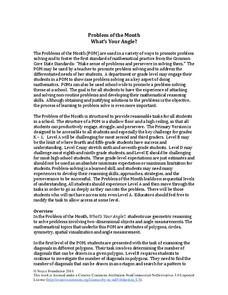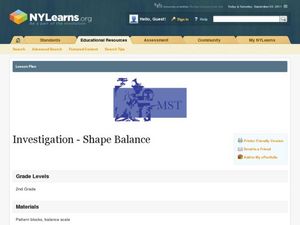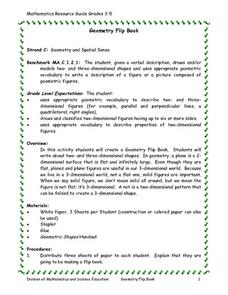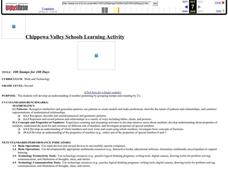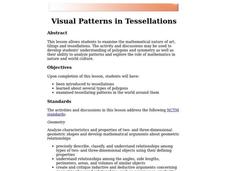Noyce Foundation
What's Your Angle?
Math can be a work of art! Reach your artistic pupils as they explore angle measures. A creative set of five problems of varying levels has young learners study interior and exterior angle measures of polygons. The introductory levels...
Curated OER
Arithmetic Sequences
Find the sequence of an equation with your math super stars. They differentiate between arithmetic and geometric sequences and then calculate the sum of finite and infinite sequences.
Curated OER
Investigation: Shape Balance
Second graders explore geometry by utilizing pattern blocks. In this shape identification lesson, 2nd graders view the characteristics for several different geometric shapes and create them using building blocks and other classroom...
Curated OER
I. M. Pei and the Geometry of the NGA
Learners compare design elements in neoclassical and modern architecture. They review knowledge of triangles and quadrilaterals and design a geometric pattern using Pei's polygons They create a city plan using a variety of lines and...
Curated OER
Mandalas, Polygons and Symmetry
Students create a geometric pattern using mandalas, polygons and symmetry. In this geometry lesson, students analyze the mathematics involved in making the mandalas, including the shapes and symmetry. Students create their own mandalas...
Curated OER
Jumping Rules
First graders practice identifying number patterns. In this basic patterns lesson, 1st graders use a large number line and jump to certain numbers to create, identify or extend a pattern. This lesson includes a script to guide the teacher.
Curated OER
Geometry Flip Book
Students investigate the concepts of geometry that can be grouped into a flip book that can be used for teaching and review purposes. They define the differences between two and three dimensional figures. Also polygons are reviewed and...
Curated OER
Making Connections
Seventh graders relate patterns with higher math. In this 7th grade math lesson, 7th graders analyze different methods of portraying data. They relate the data to real life scenarios.
Curated OER
100 Stamps for 100 Days
Second graders count by 2's to get to 100. In this counting lesson plan, 2nd graders use the program Kid Pix to create stamps two at a time until they get to 100.
Curated OER
100 Stamps for 100 Days
Students recognize similarities and generalize patterns. In this math and technology lesson plan, students develop an understanding of number patterning by grouping stamps and counting by 10s.
Curated OER
Converge or Diverge?
Students prepare for the calculus concepts of limits by examining sequences that converge and diverge. By using an Excel program that generates sequences, students manipulate the starting number, multiplier and add-on values, and examine...
CK-12 Foundation
Sums of Finite Arithmetic Series: Triangular Numbers
Using a slider, scholars build triangular numbers and their associated rectangles and use the geometric display to find the pattern to determine the next triangular number. They then relate that number to the area of the rectangle to...
Curated OER
Seven Circles II
Your learners find as many rigid motions of the plane as they can that are symmetries of the configuration of circles. Rigid transformations of the plane are explored and become more concrete to them as they visualize and execute these...
Resources for Early Childhood
Making Math Meaningful and Enjoyable
Your young learners will enjoy mathematics that is meaningful correspondence as they play their way to a deep mathematical foundation. Organized around the math standards, this appropriate sequence of conceptual, preschool...
EngageNY
Unknown Angle Proofs—Proofs with Constructions
Provide your emerging mathematicians with the tools to learn as they incorporate auxiliary lines to solve unknown angle proofs in this continuing segment. They decipher information from a diagram to uncover the missing pieces and...
Curated OER
Math Quilts
Young scholars examine geometric shapes. In this geometric shape lesson plan, students examine how geometric shapes flip, turn, and slide to create a pattern. Young scholars analyze the role that quilts played in helping slaves escape...
Curated OER
Finding The Sum of an Infinite Series
Students examine finding the sum of an infinite series as the limit of partial sums. Through hands-on activities, students create their own sequence by finding the area of a square and then cutting it in half-sized pieces. They write...
Curated OER
Visual Patterns in Tessellations
Learners explore tessellations as well as various types of polygon. Students examine tessellating patterns in the world around them. Learners examine tessellations by creating their own tessellations and completing the included worksheet.
Curated OER
Geo Jammin' By DeSign - Day 1, Lesson 1: Math in Motion
Second graders, through large screen monitor, study geometric design. They participate in a diagnostic assessment in which they use pnecils, scissors and paste.
Curated OER
Geo Jammin' By DeSign - Day 1, Lesson 2: Dancing Duo
Second graders and teachers identify geometric vocabulary word by searching a geometry website. They create a Quilt Word Wall using the geometry words.
Curated OER
Sequences and Series
In this sequences and series activity, students find the sum of a given geometric series. They use sigma notation to express a geometric series. This one-page activity contains 12 problems.
Curated OER
TAKS 3rd Grade Daily Upkeep 2
In this TAKS worksheet, 4th graders identify the number of sides in a shape, discover a pattern, and find the sum of several numbers. Questions relate to objectives covered on the Texas state test. This would be good bell work.
Curated OER
Sequences, Counting and Probability - Week 4
In this sequence worksheet, students complete problems involving geometric sequences. They identify the nth term in a sequence. Students explore various positions in the Fibonacci sequence. This two-page worksheet contains eight...
Curated OER
Mathematics: Technology and Connections
Sixth graders interpret and replicate patterns. In this patterns lesson, 6th graders are given an item with a definite pattern which they must replicate using a calculator or computer and then justify how they relate. Students listen to...


